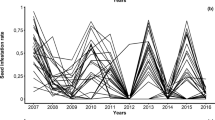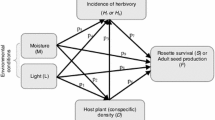Abstract
Positive density-dependent seed and seedling predation, where herbivores selectively eat seeds or seedlings of common species, is thought to play a major role in creating and maintaining plant community diversity. However, many herbivores and seed predators are known to exhibit preferences for rare foods, which could lead to negative density-dependent predation. In this study, we first demonstrate the occurrence of increased predation of locally rare tree species by a widespread group of insular seed and seedling predators, land crabs. We then build computer simulations based on these empirical data to examine the effects of such predation on diversity patterns. Simulations show that herbivore preferences for locally rare species are likely to drive scale-dependent effects on plant community diversity: at small scales these foraging patterns decrease plant community diversity via the selective consumption of rare plant species, while at the landscape level they should increase diversity, at least for short periods, by promoting clustered local dominance of a variety of species. Finally, we compared observed patterns of plant diversity at the site to those obtained via computer simulations, and found that diversity patterns generated under simulations were highly consistent with observed diversity patterns. We posit that preference for rare species by herbivores may be prevalent in low- or moderate-diversity systems, and that these effects may help explain diversity patterns across different spatial scales in such ecosystems.



Similar content being viewed by others
References
Adler PB, Ellner SP, Levine JM (2010) Coexistence of perennial plants: an embarrassment of niches. Ecol Lett 13:1019–1029
Allen JA, Anderson KP (1984) Selection by passerine birds is anti-apostatic at high prey densities. Biol J Linn Soc 23:237–246
Allen JA, Weale ME (2004) Anti-apostatic selection by wild birds on quasi-natural morphs of the land snail Cepaea hortensis: a generalized mixed models approach. Oecologia 108:335–343
Bagchi R, Swinfield T, Gallery RE, Lewis OT, Gripenberg S, Narayan L, Freckleton RP (2010) Testing the Janzen–Connell mechanism: pathogens cause overcompensating density dependence in a tropical tree. Ecology 13:1262–1269
Burger AE (2005) Dispersal and germination of seeds of Pisonia grandis, an Indo-Pacific tropical tree associated with insular seabird colonies. J Trop Ecol 21:263–271
Carson WP, Anderson JT, Leigh EG, Schnitzer SA (2008) Challenges associated with testing and falsifying the Janzen–Connell hypothesis: a review and critique. In: Carson WP, Schnitzer SA (eds) Tropical forest ecology. Wiley–Blackwell, Oxford, pp 210–241
Chen L, Mi XC, Comita LS, Zhang LW, Ren HB, Ma KP (2010) Community-level consequences of density dependence and habitat association in a subtropical broad-leaved forest. Ecol Lett 13:695–704
Clark DA, Clark DB (1984) Spacing dynamics of a tropical rainforest tree: evaluation of the Janzen–Connell model. Am Nat 124:769–788
Clarke PJ, Kerrigan RA (2002) The effects of seed predators on the recruitment of mangroves. J Ecol 90:728–736
Comita LS, Muller-Landau HC, Aguilar S, Hubbell SP (2010) Asymmetric density dependence shapes species abundances in a tropical tree community. Science 5989:330–332
Condit R, Pitman N, Leigh EG, Chave J, Terborgh J, Foster RB, Núňez P, Aguilar S, Valencia R, Villa G, Muller-Landau HC, Losos E, Hubbell SP (2002) Beta-diversity in tropical forest trees. Science 295:666–669
Connell J (1971) On the role of natural enemies in preventing competitive exclusion in some marine animals and in rain forest trees. In: Boer PD, Gradwell G (eds) Dynamics of populations. Center for Agriculture Publishing and Documentation, Wageningen, pp 283–313
Cottam DA (1985) Frequency-dependent grazing by slugs and grasshoppers. J Ecol 73:925–933
Gentry AH (1982) Patterns of neotropical plant species diversity. Evol Biol 15:1–84
Green PT, O’Dowd DJ, Lake PS (1997) Control of seedling recruitment by land crabs in rain forest on a remote oceanic island. Ecology 78:2474–2486
Harms KE, Wright SJ, Calderón O, Hernández A, Herre EA (2000) Pervasive density-dependent recruitment enhances seedling diversity in a tropical forest. Nature 404:493–495
Hassell MB (1984) Parasitism in patchy environments: inverse density dependence can be stabilizing. Math Med Biol 1:123–133
Hubbell SP, Ahumada JA, Condit R, Foster RB (2001) Local neighborhood effects on long-term survival of individual trees in a neotropical forest. Ecol Res 16:859–875
Ives AR, Carpenter SR (2007) Stability and diversity of ecosystems. Science 317:58–62
Janzen DH (1970) Herbivores and the number of tree species in tropical forests. Am Nat 104:501–528
Kreft H, Jetz W (2007) Global patterns and determinants of vascular plant diversity. Proc Natl Acad Sci USA 104:5925–5930
Lindquist ES, Carroll CR (2004) Differential seed and seedling predation by crabs: impacts on tropical coastal forest composition. Oecologia 141:661–671
Lindquist ES, Krauss KW, Green PT, O’Dowd DJ, Sherman PM, Smith TJ (2009) Land crabs as key drivers in tropical coastal forest recruitment. Biol Rev 84:203–223
Molino JF, Sabatier D (2001) Tree diversity in tropical rain forests: a validation of the intermediate disturbance hypothesis. Science 294:1702–1704
Molofsky J, Durrett R, Dushoff J, Griffeath D (1999) Local frequency dependence and global coexistence. Theor Popul Biol 55:270–282
O’Dowd DJ, Lake PS (1991) Red crabs in rain forest, Christmas Island: removal and fate of fruits and seeds. J Trop Ecol 7:113–122
Phillips O, Miller JS (2002) Global patterns of plant biodiversity. In: Alwyn H (ed) Gentry forest transect dataset. Missouri Botanical Garden Press, St. Louis
Ricklefs RE, Schluter D (1993) Species diversity in ecological communities: historical and geographical perspectives. University of Chicago Press, Chicago
Schupp EW (1992) The Janzen–Connell model for tropical tree diversity: population implications and the importance of spatial scale. Am Nat 140:526–530
Sherman PM (2002) Effects of land crabs on seedling densities and distributions in a mainland neotropical rain forest. J Trop Ecol 18:67–89
Smith TJ (1987) Seed predation in relation to tree dominance and distribution in mangrove forests. Ecology 68:266–273
Smith BH, deRivera CE, Bridgman CL, Woida JJ (1989) Frequency-dependent seed dispersal by ants of two deciduous forest herbs. Ecology 70:1645–1648
Swamy V, Terborgh JW (2010) Distance-responsive natural enemies strongly influence seedling establishment patterns of multiple species in an Amazonian rain forest. J Ecol 98:1096–1107
Terborgh J (2012) Enemies maintain hyperdiverse tropical forests. Am Nat 179:303–314
Thacker RW (1996) Food choices of land hermit crabs (Coenobita compressus H Milne Edwards) depend on past experience. J Exp Mar Biol Ecol 199:179–191
Visser MD, Muller-Landau HC, Wright SJ, Rutten G, Jansen PA (2011) Tri-trophic interactions affect density dependence of seed fate in a tropical forest palm. Eco Lett 14:1093–1100
Volkov I, Banavar J, He F, Hubbell SP, Maritan A (2005) Density dependence explains tree species abundance and diversity in tropical forests. Nature 438:658–661
Wester L (1985) Checklist of the vascular plants of the northern Line Islands. Atoll Res Bull 287:1–38
Wills C, Harms KE, Condit R, King D, Thompson J, He F, Muller-Landau HC, Ashton P, Losos E, Comita L, Hubbell S, Lafrankie J, Bunyavejchewin S, Dattaraja HS, Davies S, Esufali S, Foster R, Gunatilleke N, Gunatilleke S, Hall P, Itoh A, John R, Kiratiprayoon S, de Lao SL, Massa M, Nath C, Noor MN, Kassim AR, Sukumar R, Suresh HS, Sun IF, Tan S, Yamakura T, Zimmerman J (2006) Nonrandom processes maintain diversity in tropical forests. Science 311:527–531
Wright SJ (2002) Plant diversity in tropical forests: a review of mechanisms of species coexistence. Oecologia 130:1–14
Young HS, McCauley DJ, Dunbar RB, Dirzo R (2010a) Plants cause ecosystem nutrient depletion via the interruption of bird-derived spatial subsidies. Proc Natl Acad Sci USA 107:2072–2077
Young HS, Raab TK, McCauley DJ, Briggs AA, Dirzo R (2010b) The coconut palm, Cocos nucifera, impacts forest composition and soil characteristics at Palmyra Atoll, Central Pacific. J Veg Sci 21:1058–1068
Acknowledgments
We thank the National Science Foundation, the National Geographic Society, and Stanford’s Woods Institute for the Environment for their financial support. We also thank the US Fish and Wildlife Service for permission to work in the Palmyra Atoll National Wildlife Refuge. For assistance in the field we are very grateful to L. Anderegg, P. DeSalles, C. Hanson, A. Meyer, A. McInturff, A. Miller-ter Kuile, L. Palumbi, and T.C. Robbins. We thank A. Wegmann for advice and insight throughout. Finally, we thank three anonymous reviewers for their comments, which greatly improved the quality of this manuscript. This is publication number PARC-0092 of the Palmyra Atoll Research Consortium (PARC), and was based on collaboration and networking across multiple partner organizations in PARC, which is supported in part by the National Science Foundation under grant no. 0639185. The experiments comply with the current laws of the country (USA) in which the experiments were performed.
Author information
Authors and Affiliations
Corresponding author
Additional information
Communicated by Ines Ibanez.
Electronic supplementary material
Below is the link to the electronic supplementary material.
Rights and permissions
About this article
Cite this article
Young, H.S., McCauley, D.J., Guevara, R. et al. Consumer preference for seeds and seedlings of rare species impacts tree diversity at multiple scales. Oecologia 172, 857–867 (2013). https://doi.org/10.1007/s00442-012-2542-2
Received:
Accepted:
Published:
Issue Date:
DOI: https://doi.org/10.1007/s00442-012-2542-2




